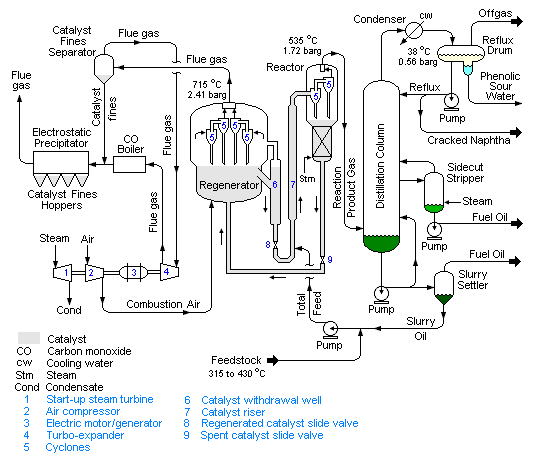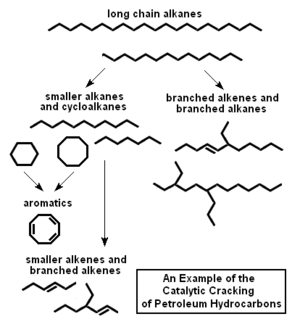User:Milton Beychok/Sandbox
The fluid catalytic cracker (FCC) is the most important conversion process unit used in petroleum refineries. It is widely used to convert the high-boiling hydrocarbon portions of petroleum crude oils to more valuable gasoline, olefinic gases and other products.[1][2][3] Catalytic cracking of petroleum hydrocarbons was originally done by thermal cracking which has been almost completely replaced by catalytic cracking because it produces more gasoline with a higher octane rating. It also produces byproduct gases that are more olefinic, and hence more valuable, than those produced by thermal cracking.
The feedstock to an FCC is usually that portion of the crude oil that has an initial boiling point of 330 °C or higher at atmospheric pressure and an average molecular weight ranging from about 200 to 500 or higher. The FCC process vaporizes and breaks the long-chain molecules of the high-boiling hydrocarbon liquids into much shorter molecules by contacting the feedstock, at a moderate pressure, with a very hot powdered catalyst.
In effect, refineries use fluid catalytic cracking to correct the imbalance between the market demand for gasoline and the excess of heavy, high boiling range products resulting from the distillation of crude oil.
As of 2006, FCC units were in operation at 400 petroleum refineries worldwide and about one-third of the crude oil refined in those refineries is processed in an FCC to produce high-octane gasoline and fuel oils.[2][4] During 2007, the FCC units in the United States processed a total of 834,300,000 litres (5,300,000 barrels per day of feedstock[5] and FCC units worldwide processed about twice that amount.
Flow diagram and process description
The modern FCC units are all continuous processes which operate 24 hours a day for as much as 2 to 3 years between shutdowns for routine maintenance.
There are a number of different proprietary designs that have been developed for modern FCC units. Each design is available under a license that must be purchased from the design developer by any petroleum refining company desiring to construct and operate an FCC of a given design.
Basically, there are two different configurations for an FCC unit: the "stacked" type where the reactor and the catalyst regenerator are contained in a single vessel with the reactor above the catalyst regenerator and the "side-by-side" type where the reactor and catalyst regenerator are in two separate vessels. These are the major FCC designers and licensors:[3][6]
Side-by-side configuration:
- ABB Lummus Global
- Exxon Research and Engineering (ERE)
- Shell Global Solutions International
- Stone & Webster Engineering Corporation (SWECO) / Institut Francais Petrole (IFP)
- Universal Oil Products (UOP)
Stacked configuration:
- Kellogg Brown & Root (KBR)
Each of the proprietary design licensors claims to have unique features and advantages. A complete discussion of the relative advantages of each of the processes is well beyond the scope of this article. Suffice it to say that all of the licensors have designed and constructed FCC units that have operated quite satisfactorily.
Reactor and Regenerator
The schematic flow diagram below of a typical modern FCC unit is based upon one of the above configurations. The preheated high-boiling petroleum feedstock (at about 315 to 430 °C) consisting of long-chain hydrocarbon molecules is combined with recycle slurry oil from the bottom of the distillation column and injected into the catalyst riser where it is vaporized and cracked into smaller molecules by contact and mixing with the very hot powdered catalyst from the regenerator. All of the cracking reactions take place in the catalyst riser. The mixture of powdered catalyst and hydrocarbon vapors flows upward like a fluid and enters the reactor at a temperature of about 535 °C and a pressure of about 1.72 barg.
The reactor is in fact merely a vessel in which the cracked product vapors are: (a) separated from the so-called spent catalyst by flowing through a set of cyclones within the reactor and (b) the spent catalyst flows downward through a steam stripping section to remove any hydrocarbon vapors before the spent catalyst returns to the catalyst regenerator. The flow of spent catalyst to the regenerator is regulated by a slide valve in the spent catalyst line.
Since the cracking reactions produce some carbonaceous material (referred to as coke) that deposits on the catalyst and very quickly reduces the catalyst reactivity, the catalyst is regenerated by burning off the deposited coke with air blown into the regenerator. The regenerator operates at a temperature of about 715 °C and a pressure of about 2.41 barg. The combustion of the coke is exothermic and it produces a large amount of heat that is partially absorbed by the regenerated catalyst and provides the heat required for the vaporization of the feedstock and the endothermic cracking reactions that take place in the catalyst riser. For that reason, FCC units are often referred to as being heat balanced.
The hot catalyst (at about 715 °C) leaving the regenerator flows into a catalyst withdrawal well where any entrained combustion flue gases are allowed to escape and flow back into the upper part to the regenerator. The flow of regenerated catalyst to the feedstock injection point below the catalyst riser is regulated by a slide valve in the regenerated catalyst line.
The amount of catalyst circulating between the regenerator and the reactor amounts to about 5 kg per kg of feedstock which is equivalent to about 4.66 kg per litre of feedstock.[1][7] Thus, an FCC unit processing 12,000,000 litres/day (75,000 barrels/day) will circulate about 55,900 metric tons per day of catalyst.
Distillation column
The reaction product vapors (at 535 °C and a pressure of 1.72 barg) flow from the top of the reactor to the bottom section of the distillation column (commonly referred to as the main fractionator) where they are distilled into the FCC end products of cracked naphtha, fuel oil and offgas. After further processing for removal of sulfur compounds, the cracked naphtha becomes a high-octane component of the refinery's blended gasolines.
The main fractionator offgas is sent to what is called a gas recovery unit where it is separated into butanes and butylenes, propane and propylene, and lower molecular weight gases (hydrogen, methane, ethylene and ethane). Some FCC gas recovery units may also separate out some of the ethane and ethylene.
Although the schematic flow diagram above depicts the main fractionator as having only one sidecut stripper and one fuel oil product, many FCC main fractionators have two sidecut strippers and produce a light fuel oil and a heavy fuel oil. Likewise, many FCC main fractionators produce a light cracked naphtha and a heavy cracked naphtha. The terminology light and heavy in this context refers to the product boiling ranges, with light products having a lower boiling range than heavy products.
The bottom product oil from the main fractionator contains residual catalyst particles which were not completely removed by the cyclones in the top of the reactor. For that reason, the bottom product oil is referred to as a slurry oil. Part of that slurry oil is recycled back into the distillation column above the entry point of the hot reaction product vapors so as to cool and partially condense the reaction product vapors. The remainder of the slurry oil is pumped through a slurry settler. The bottom oil from the slurry settler contains most of the slurry oil catalyst particles and is recycled back into the catalyst riser by combining it with the FCC feedstock oil. The so-called clarified slurry oil is withdrawn from the top of slurry settler for use elsewhere in the refinery or as a heavy fuel oil blending component.
Regenerator flue gas
Chemistry
Catalysts
History
References
- ↑ 1.0 1.1 James H. Gary and Glenn E. Handwerk (2001). Petroleum Refining: Technology and Economics, 4th Edition. CRC Press. ISBN 0-8247-0482-7.
- ↑ 2.0 2.1 James. G. Speight (2006). The Chemistry and Technology of Petroleum, 4th Edition. CRC Press. ISBN 0-8493-9067-2.
- ↑ 3.0 3.1 Reza Sadeghbeigi (2000). Fluid Catalytic Cracking Handbook, 2nd Edition. Gulf Publishing. 0-88415-289-8.
- ↑ David S.J. Jones and Peter P. Pujado (Editors) (2006). Handbook of Petroleum Processing, First Edition. Springer. ISBN 1-4020-2819-9.
- ↑ U.S. Downstream Processing of Fresh Feed Input by Catalytic Cracking Units (Energy Information Administration, U.S. Dept. of Energy)
- ↑ Editorial Staff (November 2002). "Refining Processes 2002". Hydrocarbon Processing: 108-112. ISSN 0887-0284.
- ↑ Fluid Catalytic Cracking


